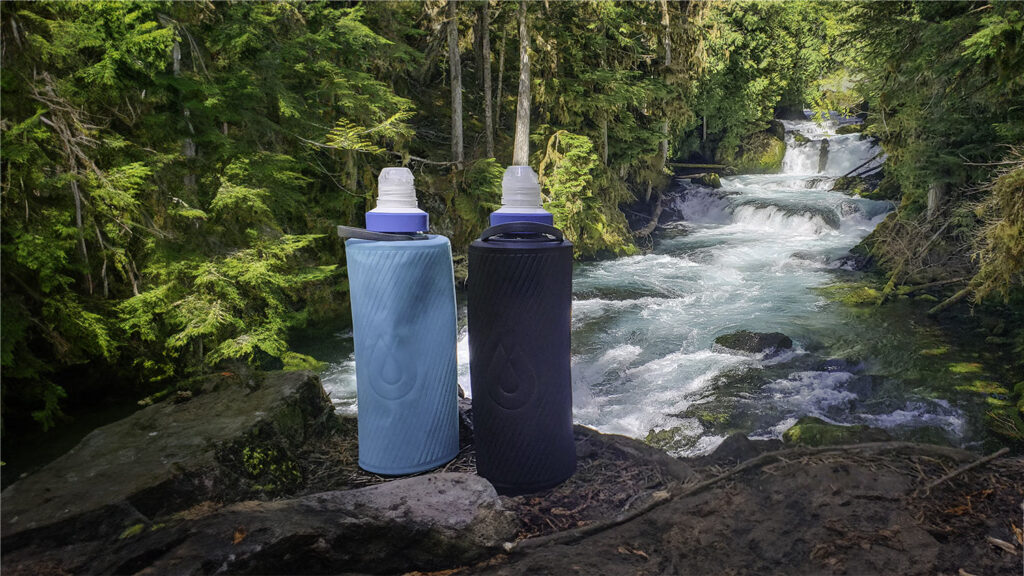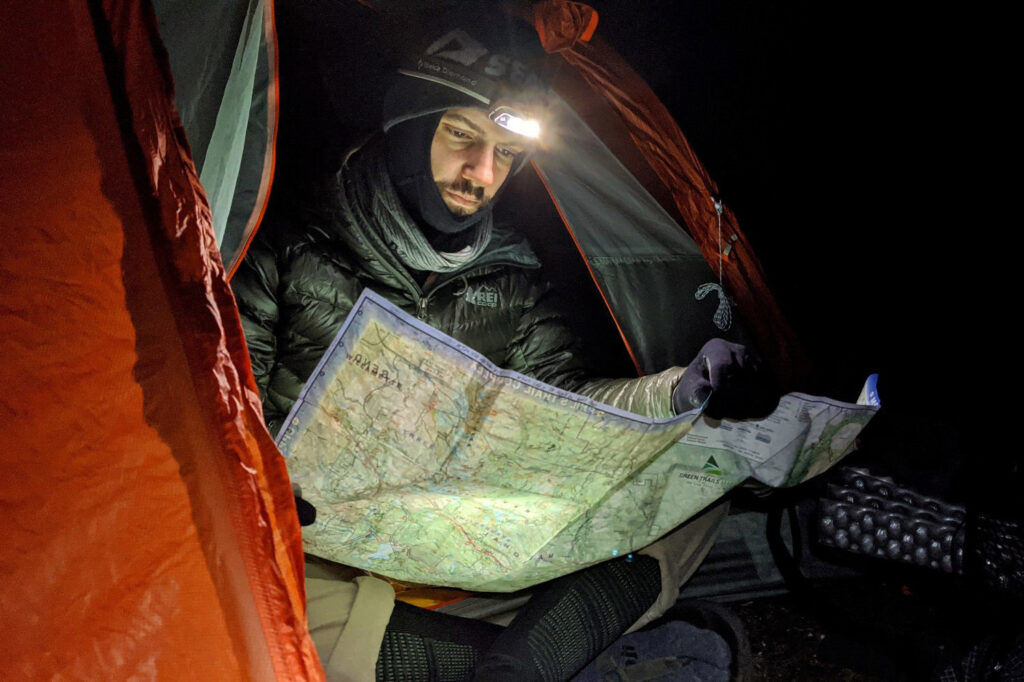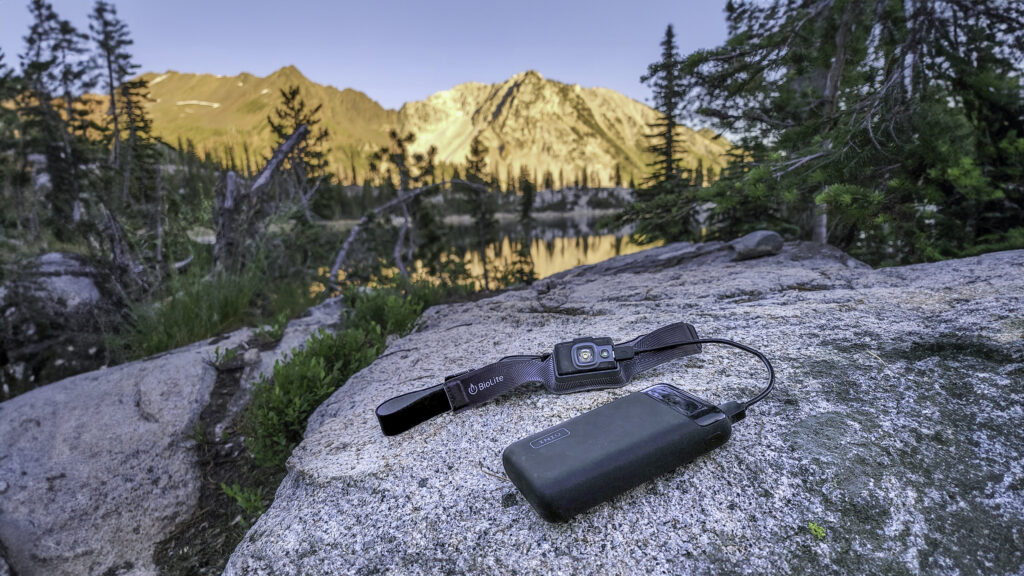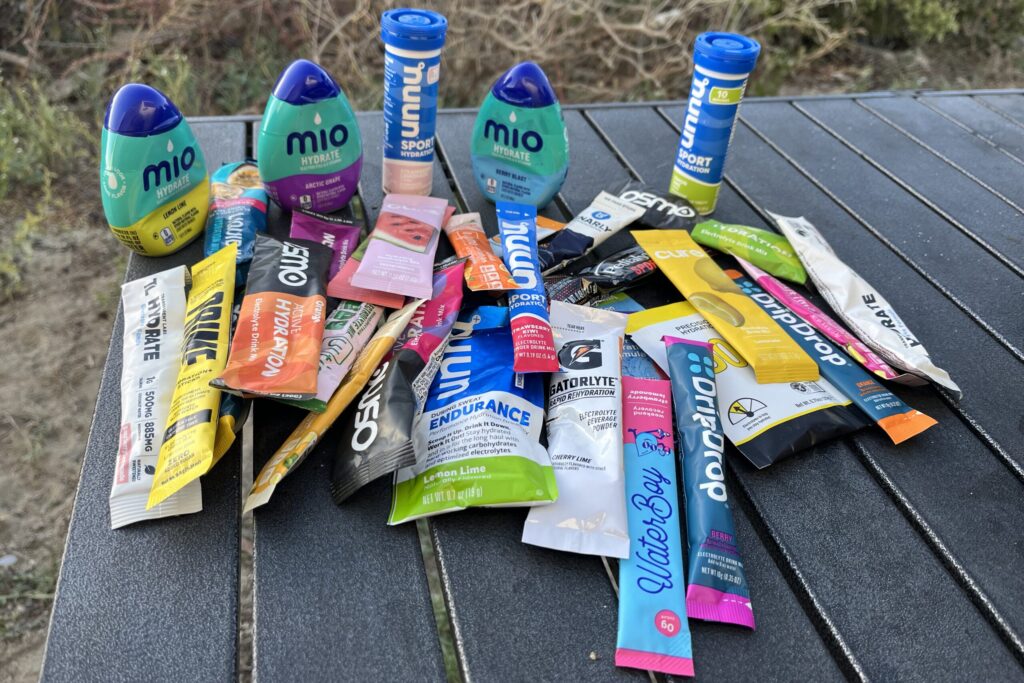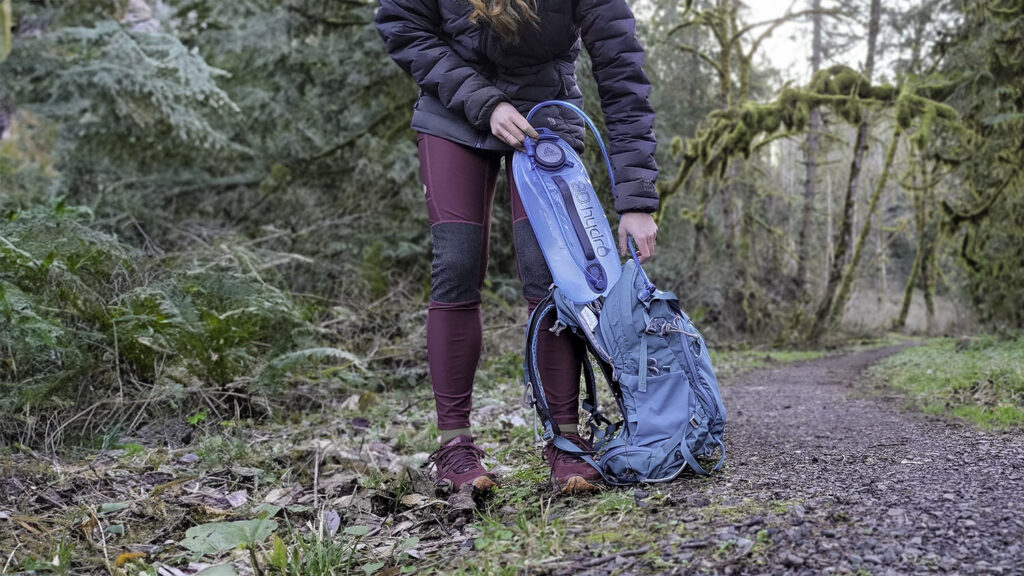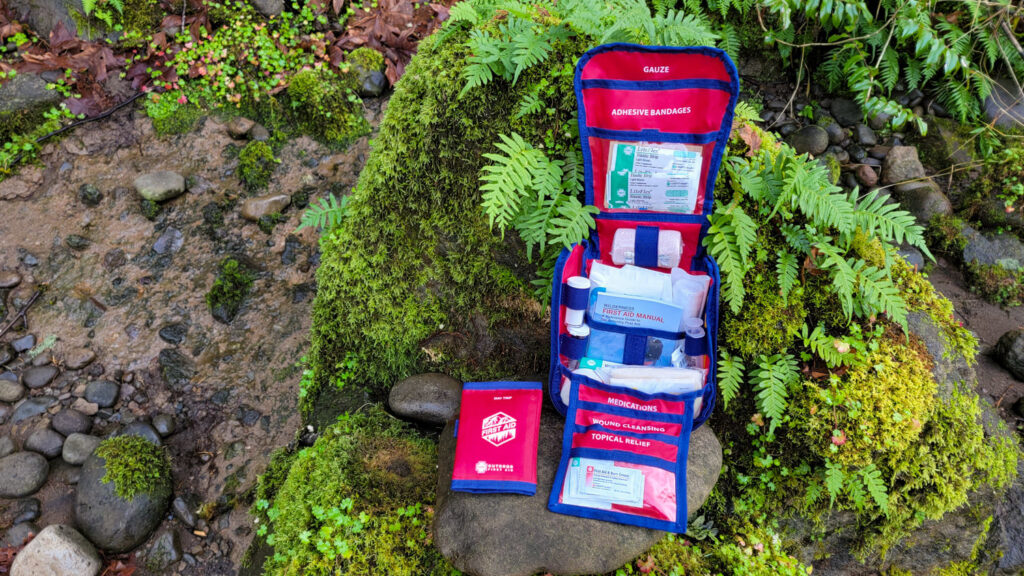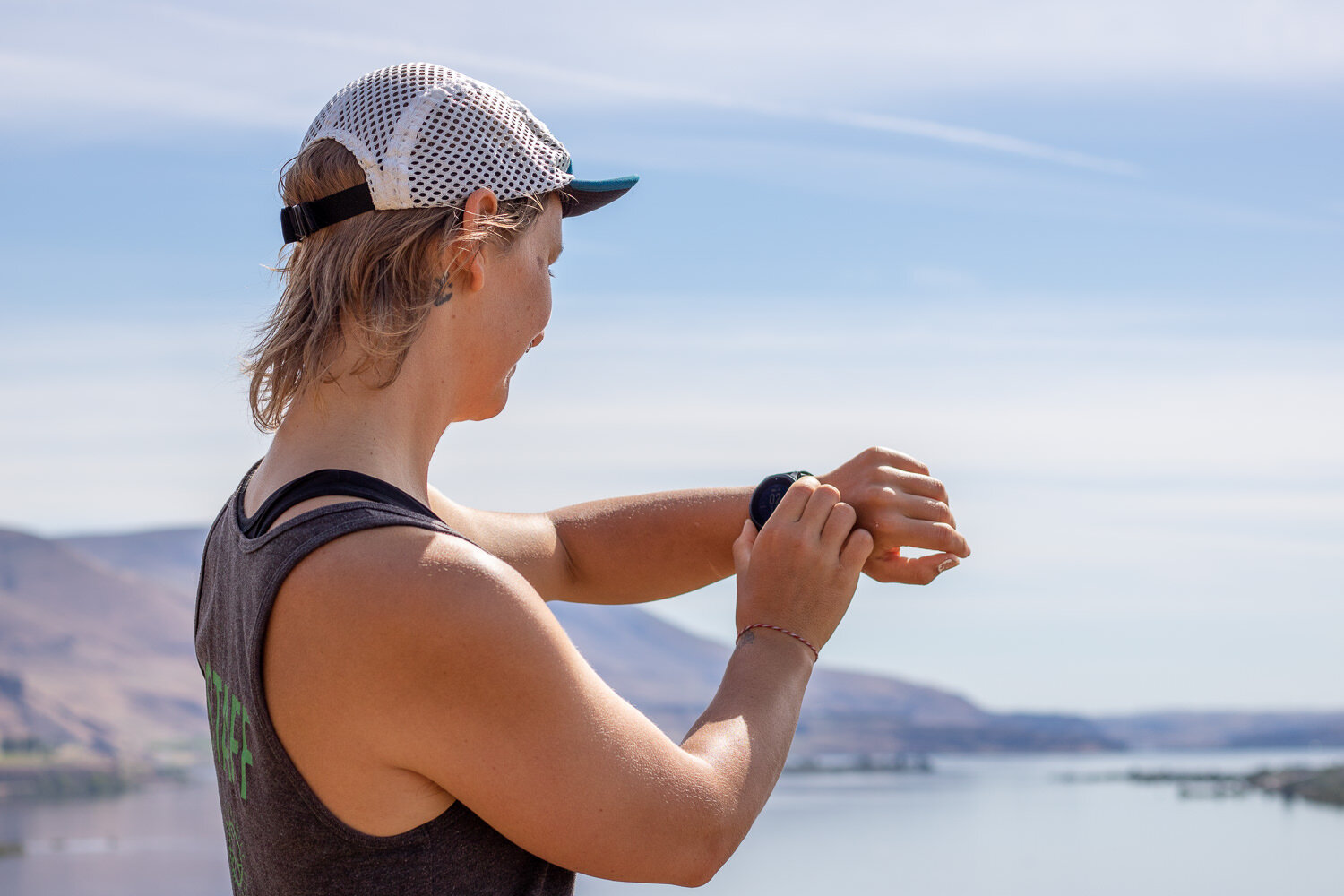
A GPS watch is a powerful tool for navigation, tracking fitness progression, and so much more. A well-designed GPS watch allows you to monitor your location and provides further insights into your performance (heart rate, calories burned, and sleeping patterns). The best GPS watches give an accurate snapshot of your overall fitness level and aid you in navigation on your next backcountry adventure.
Whether you’re looking for a mapping device, an advanced watch for marathon training, or a simple fitness tracker, CleverHiker has got you covered.
We researched and tested 30 of the hottest GPS watches to find the top performers with the best battery life, innovative features, and user interface. In this guide, we’ll help you find the best GPS watch for your budget and needs.
And for more info, check out some of our other popular gear guides:
Quick Picks for GPS Watches
Check out this quick list of our favorites, or continue scrolling to see our full list of the best GPS watches with in-depth reviews.
Best GPS Watch Overall: Coros Apex 2 Pro ($450)
Best Solar-Charging GPS Watch: Garmin Instinct 2 Solar ($400)
Best Budget Running GPS Watch: Coros Pace 3 ($229)
Best Display GPS Watch: Garmin Forerunner 165 ($250)
Best Lightweight Fitness Tracker: Garmin Vivoactive 5 ($300)
Most Stylish High-Performance Watch: Suunto 9 Peak Pro ($349)
Best Budget Watch with Impressive Features: Amazfit T-Rex 3 ($280)
What’s new
The CleverHiker team has been keeping up with the latest tech and testing new watches against our trusty go-tos:
- With its vibrant AMOLED display, the Garmin Forerunner 165 has great graphics to aid its high performance.
- The lightest watch in our lineup, the Garmin Vivoactive 5 is a great option for everyday wear and fitness tracking.
- The Suunto 9 Peak Pro has a sleek and stylish outer, making it one of our selection’s most classy GPS watches.
- The Amazfit T-Rex 3 is a great budget-friendly watch with features that punch above its weight.
GPS Watches Overall Testing Score
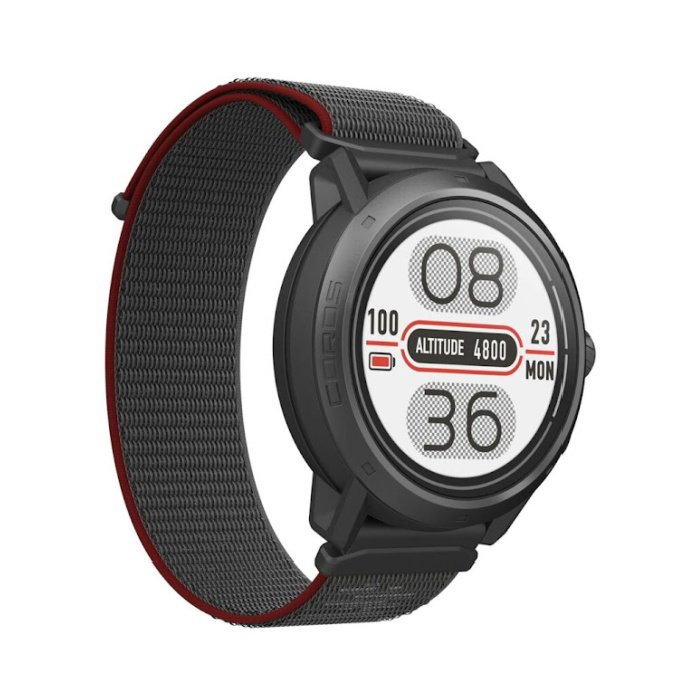
Coros Apex 2 Pro
Best GPS Watch Overall
CleverHiker Rating: 4.8/5.0
Price: $450
Avg. Battery Life: 21 days in smartwatch mode / 66 hrs. in GPS mode
Display Size: 1.3″
Weight: 52g
Pros
- Comfortable
- Highly accurate
- Best companion app
- Great mapping capability
- Large display
Cons
- Buttons easily pressed accidentally by gloves
- Lacks some smartwatch features
The Coros Apex 2 Pro is a premium quality, high-performance GPS watch designed for those who need extreme battery life and reliable navigation. With a sleek yet durable design, it balances functionality with comfort, making it a top choice for long expeditions where accuracy and endurance are essential.
Equipped with dual-frequency GPS, the Apex 2 Pro provides exceptional tracking accuracy, even in challenging environments. It maintains consistent satellite connectivity and delivers smooth, reliable route data.
With up to 66 hours of battery life in GPS mode and 21 days in smartwatch mode, it is one of the most dependable watches for multi-day trips. Ultra mode further extends its tracking capabilities, making it perfect for long adventures.
The included nylon band offers a secure yet comfortable fit, ensuring accurate heart rate monitoring. However, it does absorb sweat and requires occasional washing. The Apex 2 Pro also features a touchscreen-enabled offline topo map, a 3D compass, a barometric altimeter, and route deviation alerts, making it a powerful navigation tool. While it lacks contactless payment and other smartwatch conveniences, it excels in backcountry performance.
With its intuitive interface, large display, and best-in-class companion app, the Coros Apex 2 Pro is an outstanding GPS watch for endurance athletes and outdoor explorers who need a reliable, feature-packed device that lasts days without charging.
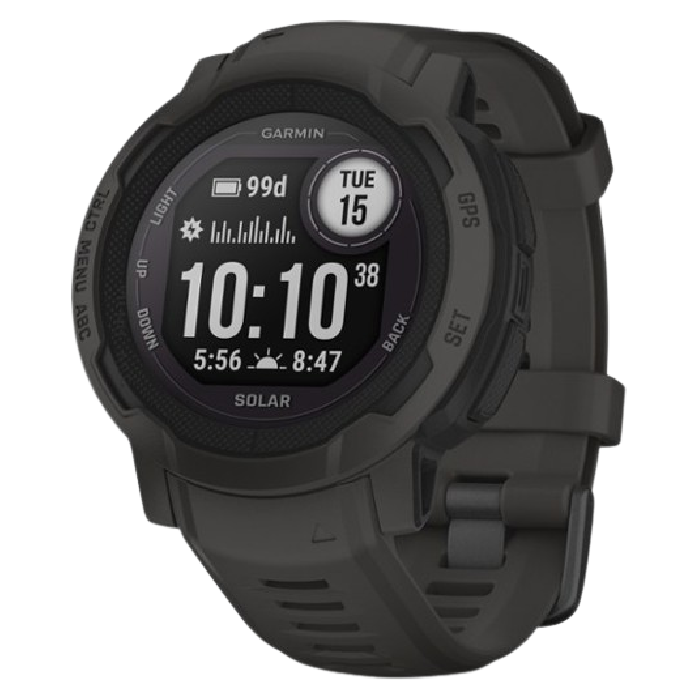
Garmin Instinct 2 Solar
Best Solar-Charging GPS Watch
CleverHiker Rating: 4.7/5.0
Price: $400
Weight: 51g
Avg. Battery Life: 28 days smartwatch / 30 hrs GPS
Ease of Use: 4.6
Pros
- User friendly
- Exceptional battery life
- Lightweight & comfortable
- Waterproof to 100 m
- Excellent companion app
- Solar charges in bright sunllight
- Many sports profiles
Cons
- A little bulky (Instinct Solar 2S is better for smaller wrists)
- No topo map function
The Garmin Instinct 2 Solar is a rugged, adventure-ready GPS watch designed for those who demand durability, accuracy, and long battery life in extreme conditions.
Built to withstand water, impact, and temperature extremes, it excels in backcountry environments where reliability is key. Its solar charging capability extends battery life significantly, making it a top choice for multi-day expeditions without access to power.
Equipped with a single-band GPS, the Instinct 2 Solar still delivers impressive tracking accuracy, even in challenging terrain such as dense forests and deep valleys. Expedition Mode extends tracking duration by limiting GPS pings to once per hour, ensuring long-term usability on extended adventures. While it lacks downloadable topo maps, its breadcrumb navigation and back-to-start function provide effective route guidance.
The Instinct 2 Solar’s design focuses on function and durability over aesthetics. Its .9-inch monochrome display enhances visibility in bright conditions while conserving battery life. Although it lacks a touchscreen, its button-based interface is intuitive and prevents accidental inputs during movement.
Beyond navigation, the watch supports a wide range of sports modes, waypoint marking, and even a unique polygon-tracing feature for field applications. With Garmin Pay and a reliable companion app, it integrates nicely into an active lifestyle. While its bulkier size and lack of dedicated smartwatch features may not appeal to everyone, the Instinct 2 Solar is an outstanding choice for outdoor enthusiasts who need a tough, long-lasting GPS watch.

Coros Pace 3
Best Budget Running Watch
CleverHiker Rating: 4.6/5/0
Price: $229
Avg. Battery Life: 15 days smartwatch / 38 hrs GPS
Weight: 39g
Display Size: 1.2″
Pros
- Affordable
- Exceptional battery life
- Good price for the features
- Very accurate GPS
- Waterproofto 50 M
- Comfortable
- Easy to use
- Excellent companion app
Cons
- Not as attractive if you prefer smartwatch style
Equipped with dual-band GPS, the Pace 3 delivers impressive accuracy across various terrains, from city streets to rugged trails. While steep terrain occasionally caused slight deviations in tracking, the overall distance accuracy remained highly reliable. Navigation features like breadcrumb tracking and route syncing via the Coros app add extra utility for trail runners and hikers.
Battery life is a standout feature. It offers up to 38 hours in GPS mode and 15 days in smartwatch mode, outlasting many competitors in its price range. While it lacks the UltraMax mode found in higher-end Coros models, it still provides enough power for extended outings without frequent recharges.
The Pace 3 includes heart rate monitoring, sleep tracking, blood oxygen saturation measurements, and a wide range of activity modes. Users can even create custom workout and activity profiles, tailoring the watch to their specific training needs. However, the touchscreen responsiveness is inconsistent, especially with gloves or moisture on the watch face. We frequently settled for the scroll wheel and button as the preferred navigation method.
With a strong balance of affordability, performance, and durability, the Coros Pace 3 is an excellent choice for runners, cyclists, and outdoor enthusiasts seeking a high-value GPS watch that doesn’t compromise essential features.
More: Coros Pace 3 Full Review
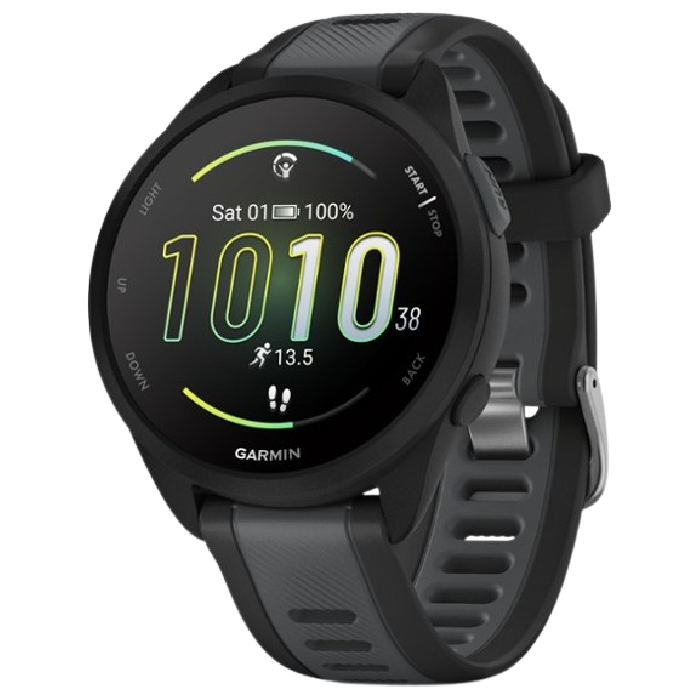
Garmin Forerunner 165
Best Display GPS Watch
CleverHiker Rating: 4.5/5.0
Price: $250
Avg. Battery Life: 11 days smartwatch / 19 hours GPS
Weight: 40g
Display Size: 1.2″
Pros
- High-quality display
- Great fitness metrics
- Accurate GPS
- Comfortable
- Built-in smart functions and training plans
Cons
- Fewer activity types
- AMOLED display lowers life
The Garmin Forerunner 165 is a well-balanced GPS watch designed for runners and fitness enthusiasts who want a high-performance tracker at an accessible price.
Its vibrant 1.2-inch AMOLED display offers crisp visuals that enhance readability for workout stats, messages, and notifications. While the high-powered screen reduces battery life, the watch still provides up to 11 days in smartwatch mode and 19 hours of continuous GPS tracking. We found it more than sufficient for daily training and most endurance activities.
Despite lacking dual-frequency GPS, the Forerunner 165 delivers impressive accuracy across various terrains. Its tracking remains consistent, with only minor deviations in dense tree cover. Users can adjust GPS settings to balance battery life and precision, making it versatile for different workout conditions. At just 39 grams, this lightweight watch is comfortable, with a sleek design that avoids interference with clothing or other gear. The low-profile buttons and intuitive interface enhance usability, while the touchscreen remains responsive even when wet or used with gloves.
The Forerunner 165 supports various sports modes, heart rate monitoring, sleep tracking, and smart features like Garmin Pay and safety alerts. While it lacks activity modes for backcountry adventures, it excels as a daily fitness tracker. For those seeking a feature-rich yet affordable GPS watch, the Forerunner 165 is a standout choice that blends advanced functionality with ease of use.
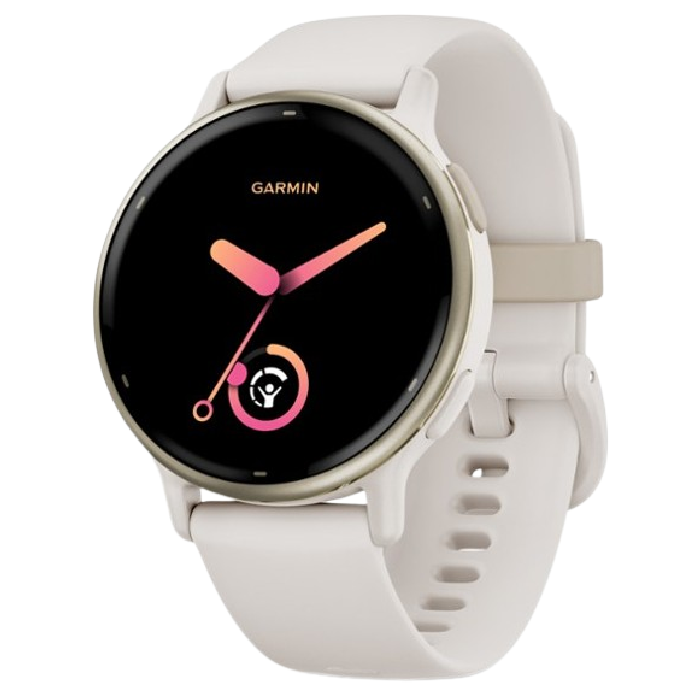
Garmin Vivoactive 5
Best Lightweight Fitness Tracker
CleverHiker Rating: 4.5/5.0
Price: $300
Avg. Battery Life: 11 days smartwatch / 17 hrs GPS
Weight: 35g
Display Size: 1.2″
Pros
- Vibrant screen
- Slim design
- Accurate GPS
- Highly modifiable screen
Cons
- No altimeter
- No navigation
The Garmin Vivoactive 5 is a slim, lightweight fitness smartwatch designed for those who prioritize health tracking and daily activity monitoring. Featuring a vibrant 1.2-inch AMOLED display, it offers excellent visibility and a sleek, low-profile design that makes it comfortable for all-day wear. At just 35 grams, it’s the lightest and thinnest watch in our lineup. It’s perfect for those with smaller wrists or anyone seeking a minimalist design.
The Vivoactive 5 accurately tracks running and has over 30 different activity types, including niche activities like gaming and platform tennis. It excels in health monitoring (functions include heart rate tracking, sleep insights, stress management, and Garmin’s Body Battery energy tracking). However, it lacks an altimeter and navigation features, making it less suited for backcountry adventures.
The Vivoactive 5’s battery life is okay, lasting up to 11 days in smartwatch mode and 17 hours with GPS tracking. In field testing, frequent GPS activity and notifications shorten its longevity, requiring more frequent charging than others in our lineup.
Ease of use is a highlight, with an intuitive touchscreen interface and a well-integrated Garmin companion app for deeper metric analysis. While it lacks advanced smartwatch features like offline music and Garmin Pay, it delivers a seamless fitness tracking experience. The Vivoactive 5 is an excellent choice for an all-around fitness smartwatch with a comfortable, streamlined design, ideal for those focused on wellness and daily activity rather than outdoor navigation.
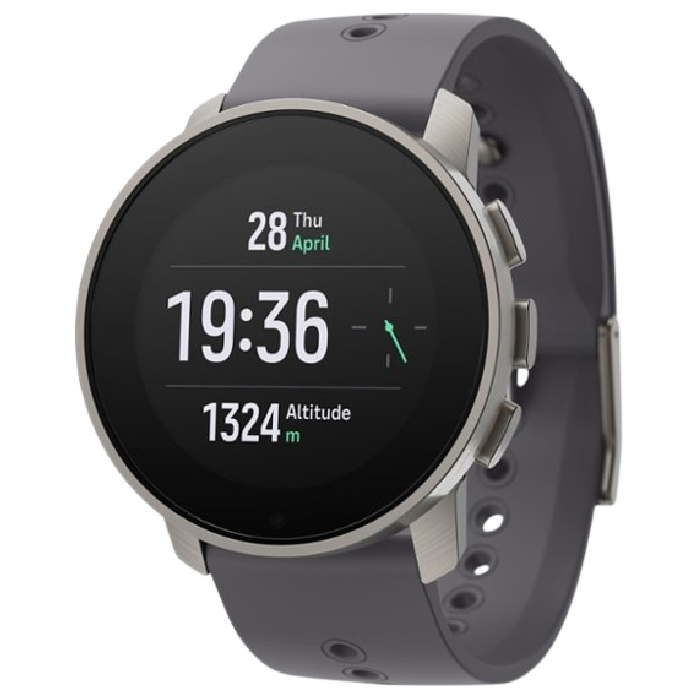
Suunto 9 Peak Pro GPS Watch
Most Stylish High-Performance Watch
CleverHiker Rating: 4.3/5.0
Price: $349
Avg. Battery Life: 21 days smartwatch / 40 hrs GPS
Weight: 55g
Display Size: 1.2″
Pros
- Stylish
- Large display
- Fast processing
- Easy to navigate
- Accurate GPS
Cons
- Not the most comfortable
- Less battery life than expected
The Suunto 9 Peak Pro redefines a performance watch, combining sleek aesthetics with high-end functionality.
Its titanium bezel and slim design make it a rare GPS watch that transitions seamlessly from rugged outdoor adventures to everyday wear. Despite its stylish build, it remains a powerful tool for athletes and outdoor enthusiasts.
One of the standout features of the Suunto 9 Peak Pro is its exceptionally responsive touchscreen, which works smoothly even in wet conditions or while wearing gloves. Its fast processor ensures lag-free operation, rapid data storage, and quick activity analysis.
The GPS tracking is highly accurate, reliably mapping routes and elevation gain without errant data points. However, heart rate monitoring can be inconsistent due to the watch’s fit, so an external monitor is recommended for precise readings.
Battery life is a mixed bag. While advertised at 40 hours in GPS mode, real-world testing showed faster drainage, especially in cold weather. However, the watch recharges quickly, minimizing downtime between uses.
The Suunto 9 Peak Pro offers a vast array of activity modes and customizable sports profiles. The interface is a little unintuitive and found the companion app challenging. Still, it provides essential navigation features like route following and turn-by-turn directions. While it falls short in smartwatch capabilities, it excels as a durable, high-performing GPS watch for those who value style and function.
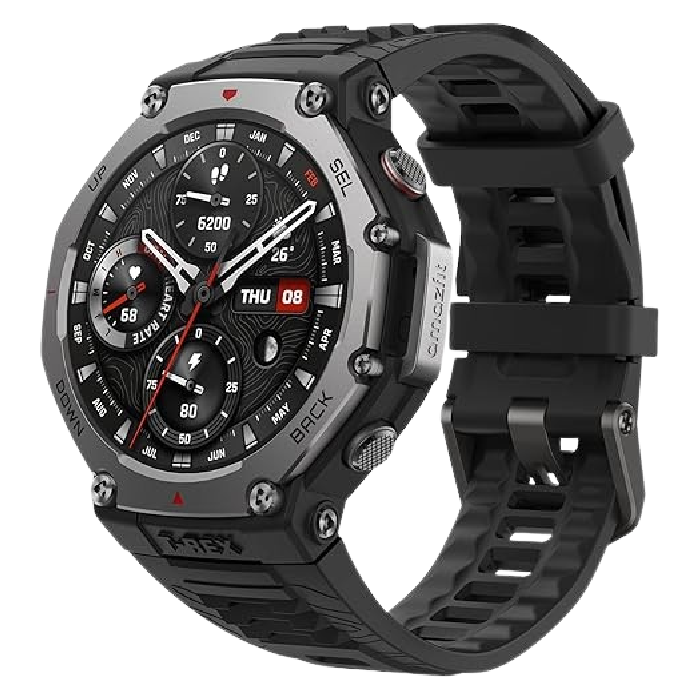
Amazfit T-Rex 3
Best Budget Watch with Impressive Features
CleverHiker Rating: 4.0/5.0
Price: $280
Avg. Battery Life: 27 days smartwatch / 42 hrs GPS
Weight: 67g
Display Size: 1.5″
Pros
- Good value
- Offline maps & maps capability
- Good battery life
- Many activity types
- Large screen
Cons
- Bulky
- Difficult to use companion app
The Amazfit T-Rex 3 is a feature-packed, budget-friendly smartwatch built for adventure. Designed for durability, it boasts a rugged exterior, impressive GPS accuracy, and a vibrant 1.5-inch AMOLED touchscreen. With offline topo maps and turn-by-turn navigation, it stands out as a rare option in its price range for backcountry navigation. The watch supports over 170 activity modes, covering everything from paragliding to chess, ensuring versatility for all users.
The T-Rex 3 also has impressive battery life for the price, lasting up to 27 days in standard smartwatch mode and up to 42 hours in GPS mode. This makes it an excellent choice for extended outdoor excursions without frequent charging. However, GPS connectivity requires regular syncing with the app for optimal accuracy, and satellite acquisition can be slower than more expensive watches.
While the T-Rex 3 is packed with useful features, it has some drawbacks. The watch is bulky and heavy, making it less comfortable for long-term wear, especially on slender wrists. Its optical heart rate sensor can be inconsistent, and syncing routes or third-party integrations can be slow and unreliable. The app, while functional, is finicky and prone to crashes, requiring patience to navigate.
Despite its quirks, the Amazfit T-Rex 3 delivers excellent value. For those seeking a durable, adventure-ready smartwatch with strong battery life and extensive tracking capabilities at an affordable price, it’s a solid choice as long as you don’t mind a learning curve and a bit of extra weight on your wrist.
Product Comparison Table
| oSort | Product | Price | Avg. Battery Life | Weight | Accuracy | Battery Life | Comfort & Wearability | Features | Ease of Use | 0 |
Coros Apex 2 Pro View at REI View at Amazon |
$450 | 21 days in smartwatch mode / 66 hrs. in GPS mode | 52g | 4.8 | 4.8 | 4.8 | 4.8 | 4.7 | 1 |
Garmin Instinct 2 Solar View at REI View at Amazon |
$400 | 28 days smartwatch / 30 hrs GPS | 51g | 4.7 | 4.7 | 4.6 | 4.7 | 4.6 | 2 |
Coros Pace 3 View at REI View at Amazon |
$229 | 15 days smartwatch / 38 hrs GPS | 39g | 4.7 | 4.7 | 4.6 | 4.6 | 4.6 | 3 |
Garmin Forerunner 165 View at REI View at Amazon |
$250 | 11 days smartwatch / 19 hours GPS | 40g | 4.5 | 4.4 | 4.5 | 4.5 | 4.5 | 4 |
Garmin Vivoactive 5 View at REI View at Amazon |
$300 | 11 days smartwatch / 17 hrs GPS | 35g | 4.5 | 4.4 | 4.6 | 4.4 | 4.5 | 5 |
Suunto 9 Peak Pro GPS Watch View at REI View at Amazon |
$349 | 21 days smartwatch / 40 hrs GPS | 55g | 4.4 | 4.0 | 3.8 | 4.4 | 4.0 | 6 |
Amazfit T-Rex 3 View at Amazfit View at Amazon |
$280 | 27 days smartwatch / 42 hrs GPS | 67g | 4.0 | 4.5 | 3.9 | 4.4 | 3.9 |
|---|
How We Test & Methodology
ACCURACY
A GPS watch can be a big investment, but it’s one that’s sure to provide a lot of value for your active lifestyle. More expensive watches tend to have more in-depth sport tracking capabilities with a ton of fitness and navigation data. Budget-friendly watches are great for those needing a simple fitness tracker for things like counting steps and monitoring heart rate.

BATTERY LIFE
We start by charging every watch 100%, and then we wear each watch for daily use and GPS recording until it completely dies. We note approximately how much battery percentage is lost per hour of GPS recording and what conditions drain the battery the fastest. We also evaluate how long it takes the watch to recharge back to 100%.

WEARBILITY & COMFORT
Using each watch for hours and days at a time is crucial to evaluating wearability and comfort. From daily use to exercising to sleeping, we wear every watch extensively and evaluate its comfort on the body. We also note how the watch interferes with jackets, gloves, and backpack straps while on the wrist.
FEATURES
We explore every option each watch offers. Features play an important role in a GPS watch’s performance, from sports modes to smartwatch compatibility to sensors and recording metrics.
For backcountry use, we also evaluate the watch’s navigation and offline mapping features to keep us on track when out of service. We examine every feature each watch offers and evaluate how it impacts the user experience and function of the product.
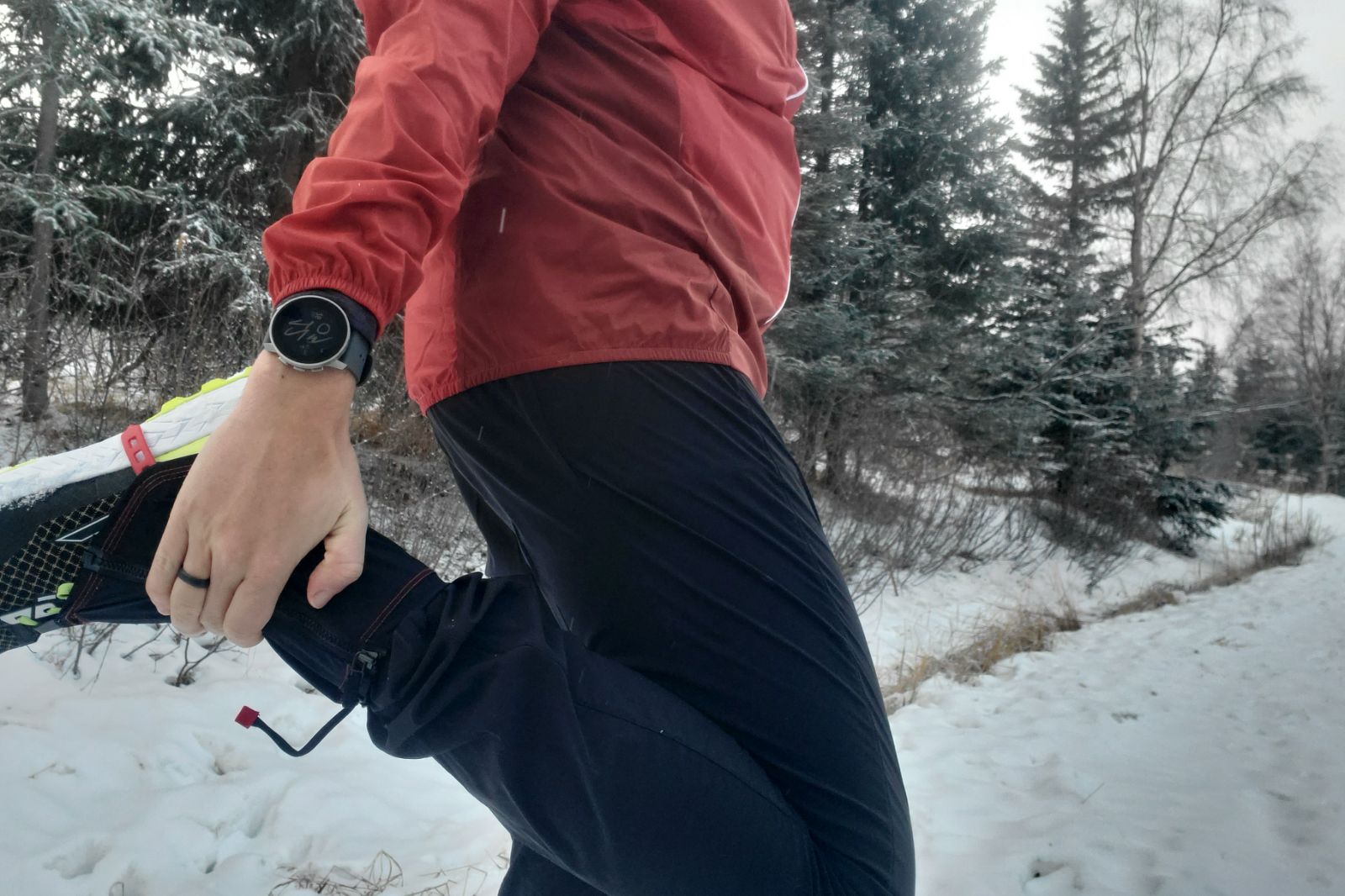
EASE OF USE
User interface is key to easily accessing the data you need to inform your next adventure. We explore every watch in-depth to analyze how easy it is to use.
From menus to customizable watch faces to navigation, we carefully examine every aspect of each product’s usability. We also explore each brand’s companion app to see how it supplements the watch and aids in data analysis.
Why Trust CleverHiker
The CleverHiker team carefully evaluated the top thirty watches on the market and narrowed them down to the seven best performers. From market analysis to field testing, we take pride in our diligence, commitment to detail, and thorough field testing.
With testing led by Gear Analyst, Miles Knotek, every product has been screened, examined, and reviewed to bring you the best selection possible. For the last decade, Miles has used GPS watches to track everything from backcountry ice skating adventures to multi-day backpacking trips to ultra-distance running races. He is meticulous with his analysis of data and performance metrics. Whether hitting splits on the track or recording vertical gain on big days in the backcountry, Miles puts every product he uses through its paces. His keen eye for detail and rigorous field testing produce thorough and well-rounded product analysis so you can make the most informed decision possible. In other words, he’s CleverHiker’s techiest gearhead, and perfect for reviewing GPS watches.
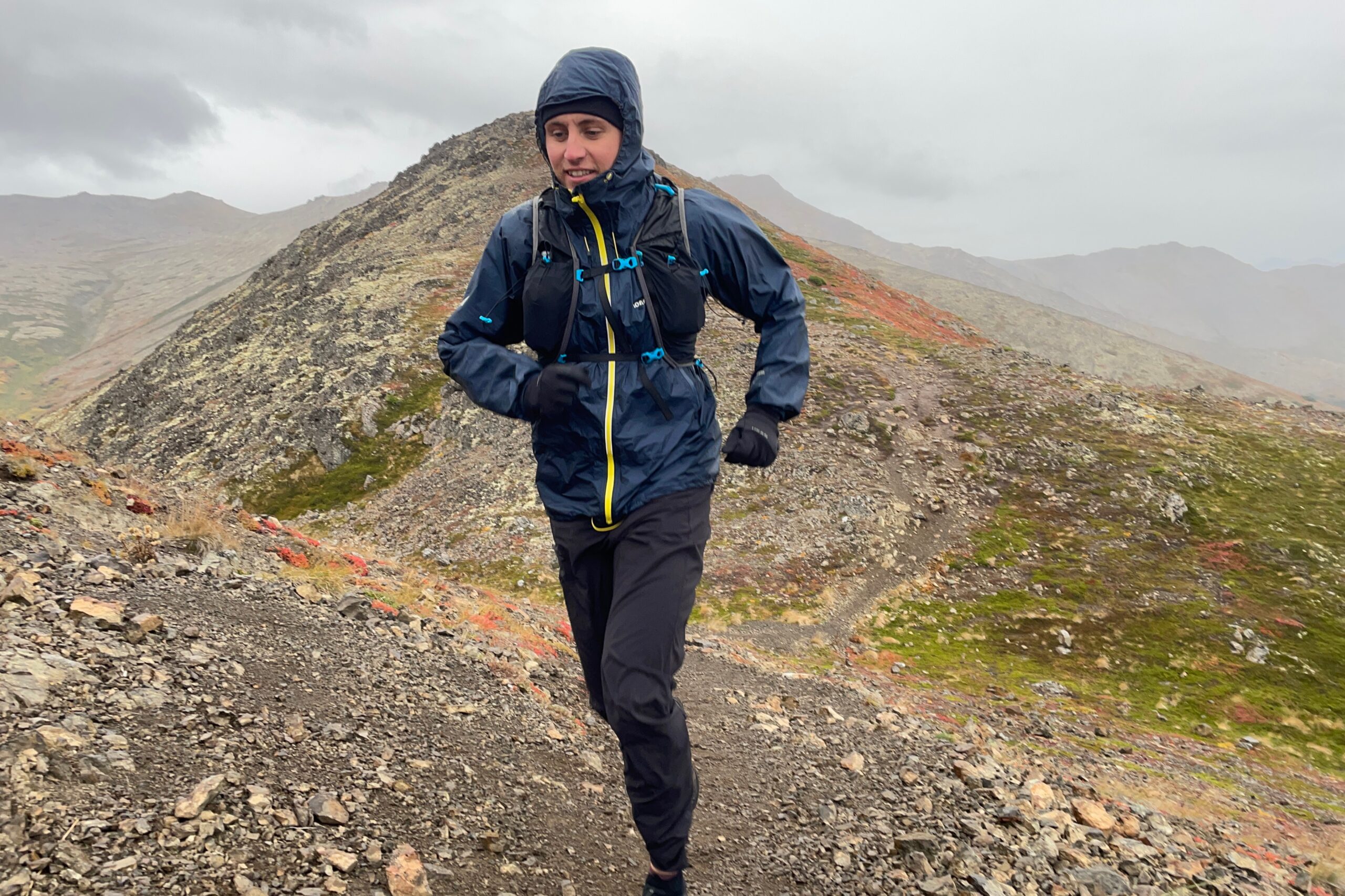
Analysis & Results
VALUE
GPS watches are expensive pieces of gear, and as such, we are always searching for ones that give the best bang for our buck. While the watch with the best value might not always be the cheapest, we define value as the combination of an accessible price with excellent performance. Considering that, the Coros Pace 3 and the Garmin Forerunner 165 win for highest overall value.
The Pace 3 offers an impressive battery life while still being one of our lineup’s thinnest and lightest watches. Its excellent user interface makes it easy to navigate, and its attainable price point makes it the perfect entry-level option.
Meanwhile, the Forerunner 165 is the least expensive watch we reviewed with an AMOLED display. Its vibrant display makes reading messages, analyzing data, and viewing menus easy and visually pleasing. While it has a shorter battery life than the Pace 3, long-time Garmin users will find comfort and familiarity in this simple yet excellently designed watch for running and fitness.
ACCURACY
GPS watches vary in accuracy based on satellite connectivity, environmental conditions, and hardware capabilities. As far as hardware capabilities are concerned, there are two major categories GPS watches fall into: dual frequency and single frequency.
Single-frequency watches receive GPS connectivity from only one frequency band, making them more prone to errors and interference from things like tall buildings, trees, or mountains.
Dual-frequency watches are more reliable and cut out many of the errors found in single-frequency watches.
The Coros Apex 2 Pro is a clear leader in accuracy thanks to its dual-frequency reliability. It had no problems recording highly accurate data in all of our tests, and it kept us on track even through dense woods and tight valleys. Similarly, the Coros Pace 3 also has dual-frequency accuracy, albeit with less customization available to change satellite connectivity for battery longevity. The Garmin Instinct 2 Solar is a single-frequency GPS watch that still provides impressive accuracy and was reliable through all our tests.
BATTERY LIFE
Having a long battery life is key if you use your watch in the backcountry or go long periods between charges. The best GPS watches have enough battery for GPS tracking for at least 24 hours and for smartwatch mode for at least a week. This allows you to go a week or two of regular use without charges or for one huge endurance push of continuous tracking.
We’ve used GPS watches for upwards of two days straight on ultra-distance adventures and love turning on the watch and not having to worry about the battery. The ability to reliably track stats for days at a time is crucial for endurance athletes or anyone who wants to dive into their stats.
With its 66 hours of GPS recording battery life, the Coros Apex 2 Pro leads the pack. We regularly used this watch for over two weeks of regular use and GPS recording without recharging it. With the ability to run for almost two and a half days continuously, it’s perfect for anyone recording long efforts or wanting to track their every movement for long periods.
The Garmin Instinct 2 Solar is unique in that it has solar charging capabilities through the watch face. While this doesn’t completely erase the need for a charger, it certainly extends that battery life, especially when used in low-power or smartwatch mode. Even without solar charging, its battery alone is enough to beat out most of the competition.
WEARABILITY & COMFORT
If you’re anything like us, you prefer a watch that feels like a part of your body and is easy to forget about when you’re wearing it. We like watches that are light and thin and have rounded bezels so they do not interfere with putting on a backpack shoulder strap or get in the way of the cuffs of jackets or gloves.
The Garmin Vivoactive 5 is the smallest and lightest watch in our lineup, making it one of the most comfortable to wear for long periods. It was the watch we noticed the least while sleeping, making it our top pick for a daily fitness and wellness tracker.
The included nylon strap of the Coros Apex 2 Pro surprised us with its comfort and ability to cinch down to provide accurate heart rate data. While it’s a bigger and heavier watch, the watchband keeps it securely and comfortably in place.
While equipped with a standard silicone band, the Coros Pace 3 is heavily aerated, relieving any sweatiness and clamminess found under other watch bands.
FEATURES
For backcountry use, we appreciate watches that have offline maps. Using topo maps from your wrist is an excellent feature for anyone needing to get a better lay of the land.
The Coros Apex 2 Pro and Amazfit T-Rex 3 have well-designed maps that can be downloaded from the app and synced to the watch for later use. Both watches can also have routes uploaded to them through the app. Simply import a route file to the app, sync it to the watch, and never get lost again.
Two other options that pack a lot of features into a slim platform are the Garmin Forerunner 165 and the Coros Pace 3. Both of these watches have impressive health and fitness tracking metrics, altimeters, and great companion apps. These watches cater more towards the running and fitness crowd with their athletics-focused features like live Strava segments and seamless third-party app pairing.
EASE OF USE
We don’t want to add to our daily screen time when out on an adventure. Ideally, we like to spend less time fiddling with our devices and more time focusing on the adventure at hand.
A watch with a refined and straightforward user interface is intuitive to use and ensures that you spend more time looking at the scenery and less time trying to figure out your heart rate.
Today, many watches incorporate a touch screen. While that does make using the watch easier, it can lead to more accidental pauses. Watches with buttons and touch screens allow the most flexibility when manipulating the menus and features.
Garmin products have long led the way with their intuitive design and user-friendly interface. Nowhere is this truer than in Garmin Forerunner 165 and Garmin Vivoactive 5. Both have very similar structures and abilities with easily navigable menus, touch screen and button manipulation, and intuitive organization.
The Coros Pace 3 and Coros Apex 2 Pro products are similarly easy to use but with key differences. The first is that they incorporate a scroll wheel as one of their buttons. This makes scrolling through menus or unlocking the watch face quick and easy. The second is that they have quick and easy access to the settings menu for advanced modification of the watch. Simply hold down the back button to quickly access settings and more features.
How to Choose a GPS Watch
With the rapid enhancement of wearable technology, a GPS watch has become an essential tool for outdoor athletes and weekend hikers. From keeping track of health stats to backcountry navigation, a GPS watch can provide insights into your performance and help guide you on your next adventure. Whether hiking, trail running, or backpacking, choosing the right watch depends on your specific needs and the features that matter most to you and your intended activities.
GPS PERFORMANCE & NAVIGATION FEATURES
Having a strong and reliable GPS is crucial to accurately tracking your activities and finding your way outdoors. Dual-frequency GPS watches provide some of the most accurate GPS data because they are less affected by interference from buildings, trees, or mountains. Some watches offer breadcrumb navigation, offline maps, and route guidance, useful for long treks or traveling through unfamiliar terrain.
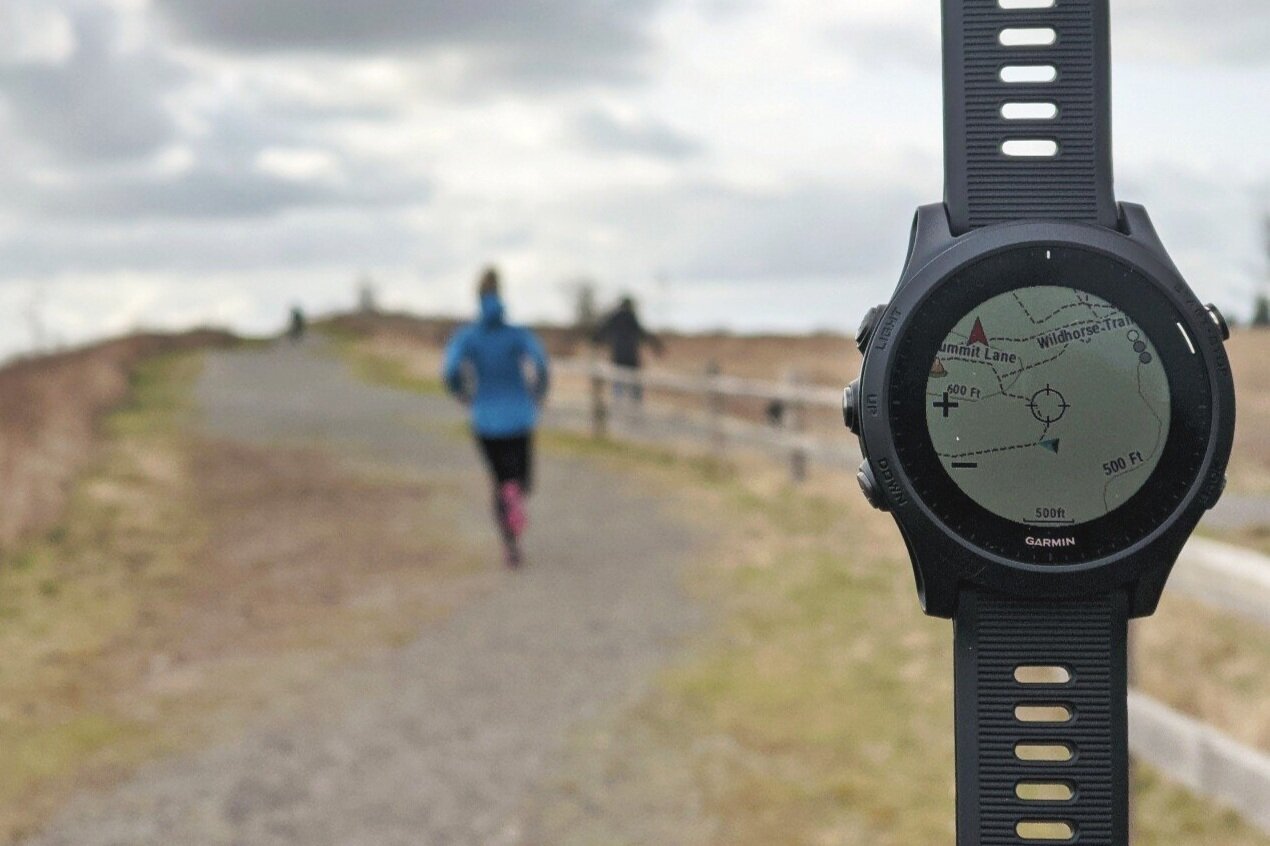
BATTERY LIFE & POWER MODES
Battery performance varies widely from a few hours to a few days. Consider what activities you’ll use the watch for the most, and how long you anticipate going between charges.
Watches with low-frequency GPS modes or solar charging can last days, while simpler models may only offer a few hours of continuous tracking. If you plan multi-day trips, look for energy-efficient settings that reduce power consumption while maintaining essential functions.
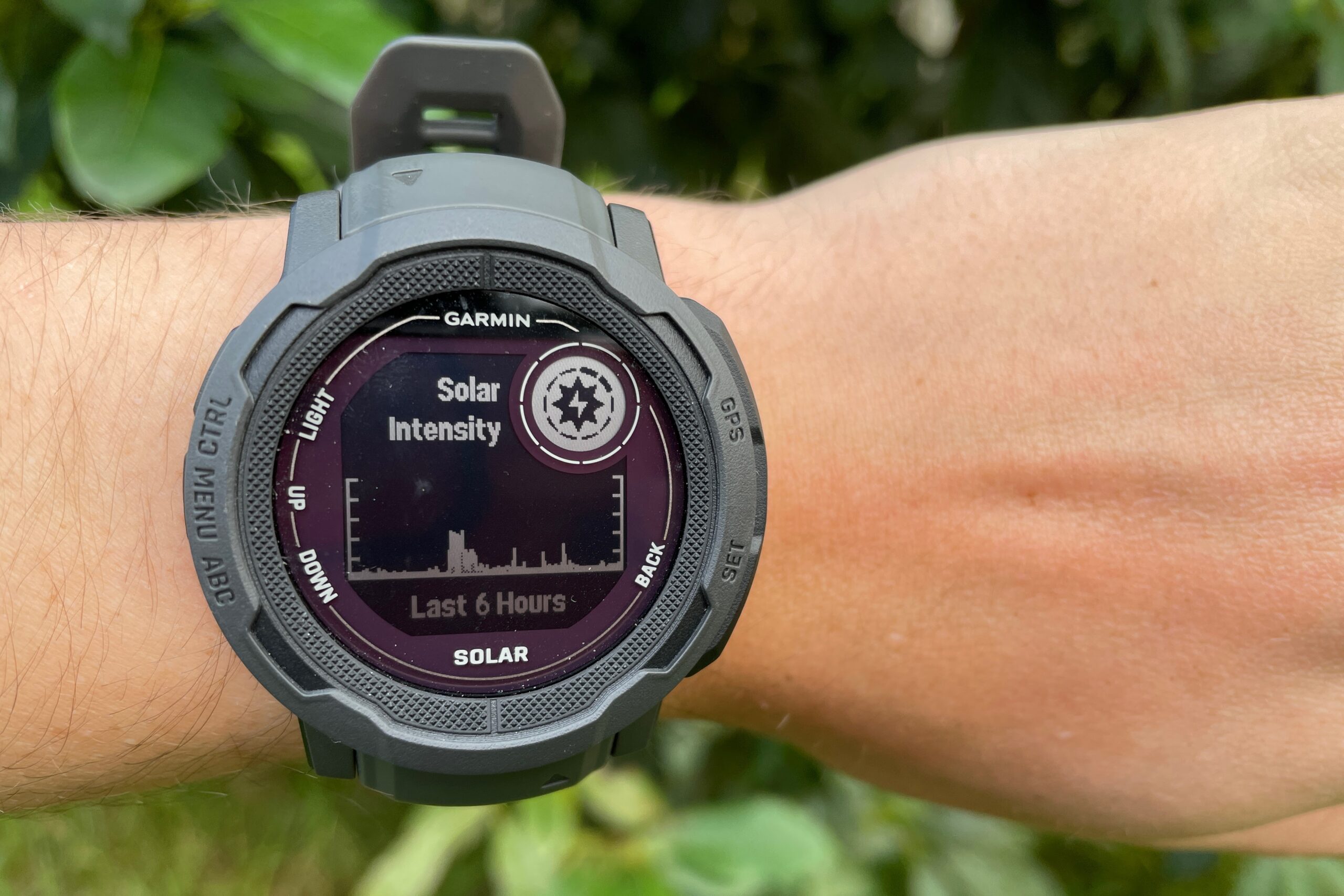
DURABILITY & WEATHER RESISTANCE
Regular outdoor use wears out any gear, especially electronics. GPS watches are no different, so choosing a durable one is key. Military-grade durability, water resistance, and scratch-resistant materials will ensure your watch can withstand harsh environments.
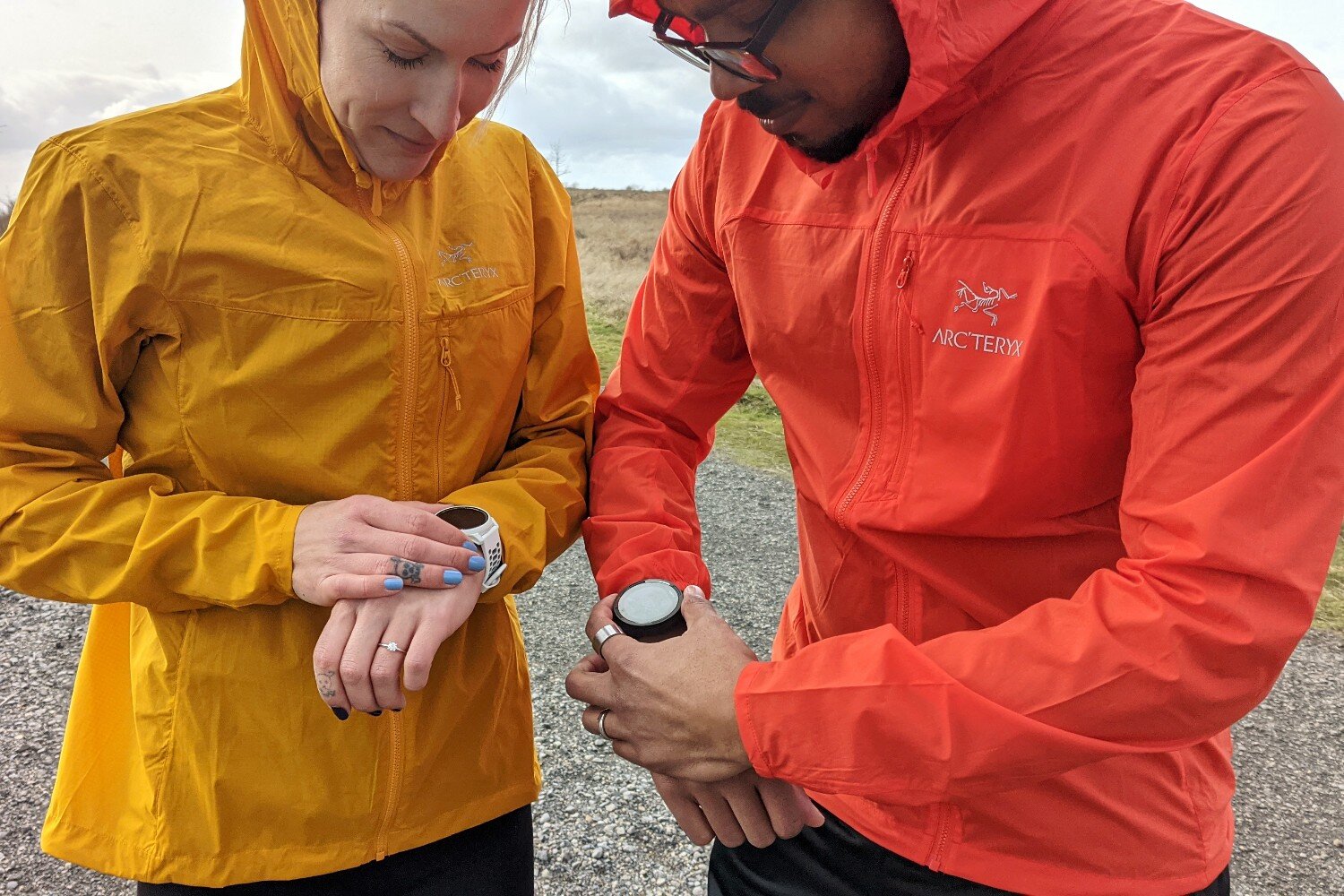
HEALTH & PERFORMANCE TRACKING
Most GPS watches include fitness metrics like heart rate monitoring, VO2 max estimation, and sleep tracking. If you train for endurance sports, look for advanced analytics such as heart rate variability, recovery time suggestions, and altitude acclimation features.
Some watches will even create AI-assisted training plans to aid your training progress. Those adventuring at higher altitudes may also benefit from a built-in barometer, altimeter, and pulse oximeter.
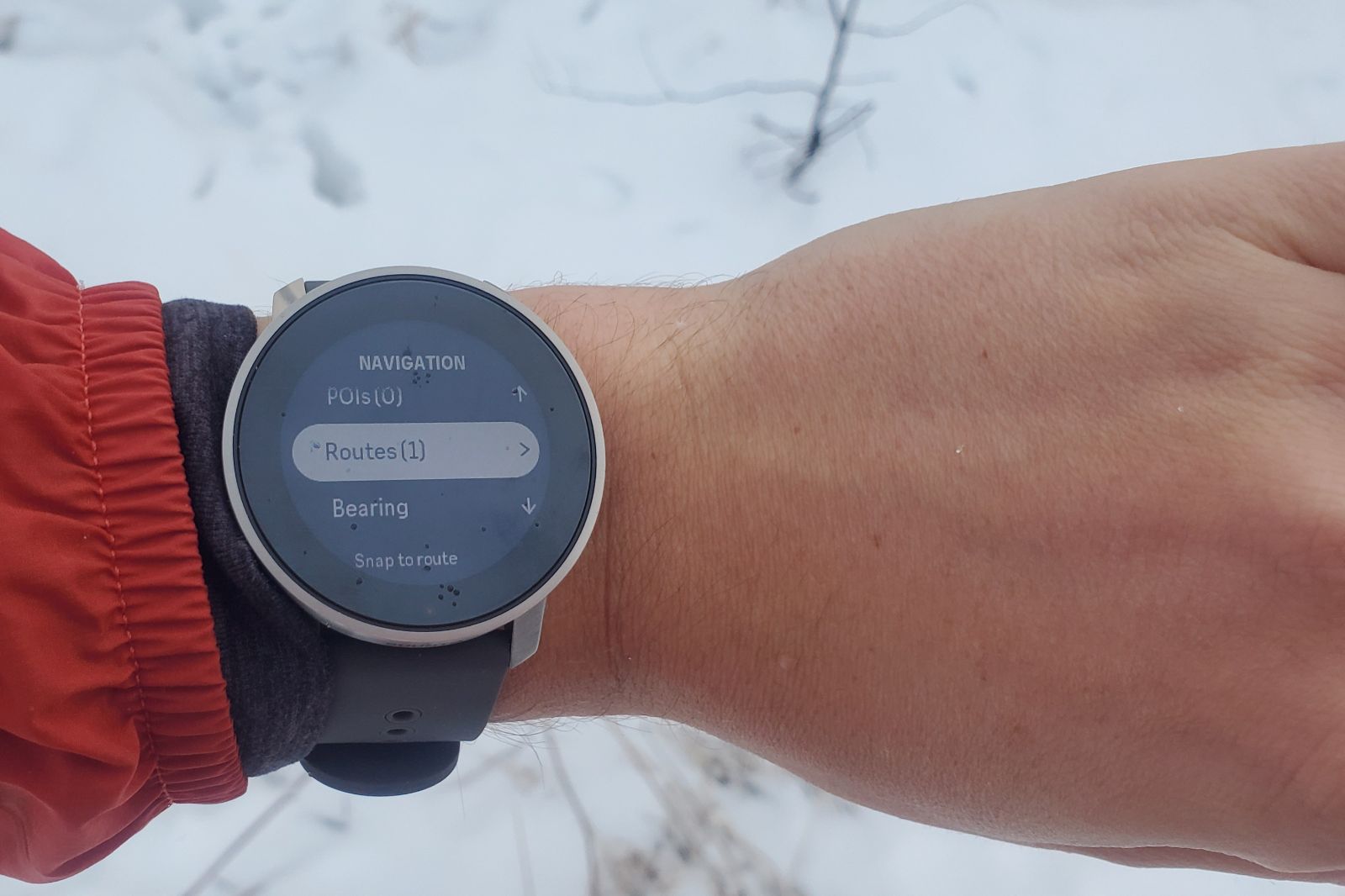
CONNECTIVITY & SMART FEATURES
For those who want more than just recording distance and pace, many GPS watches offer Bluetooth and Wi-Fi connectivity, allowing for smartphone notifications, music storage, and app integration.
Other smart features include contactless payment, camera control, and messaging. If you plan to use external sensors like chest heart rate monitors or power meters, ensure your watch is compatible with Bluetooth accessories.
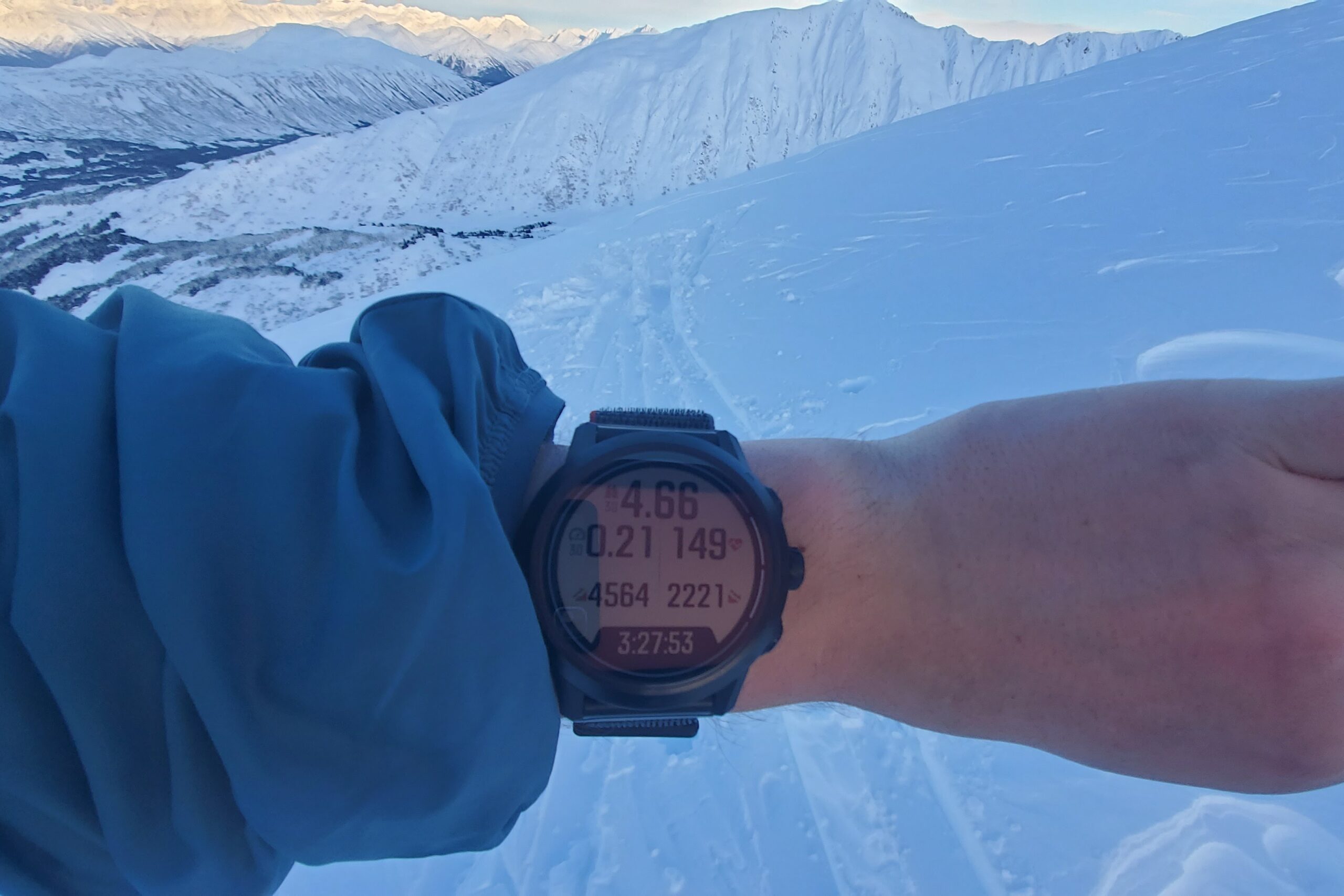
COMFORT & USEABILITY
A good GPS watch should be comfortable enough for all-day wear. Nylon bands offer elastic comfort, while less expensive plastic bands can dig into the skin uncomfortably. An easy-to-read display under bright sunlight or in low-light conditions is essential for daily use and high-stakes performance settings.
AMOLED displays offer the best visibility and definition, while lower-definition screens prioritize battery life. While touchscreens can be convenient, they may be challenging to use with gloves or in the rain. A watch with button controls is preferable for cold-weather or wet conditions.
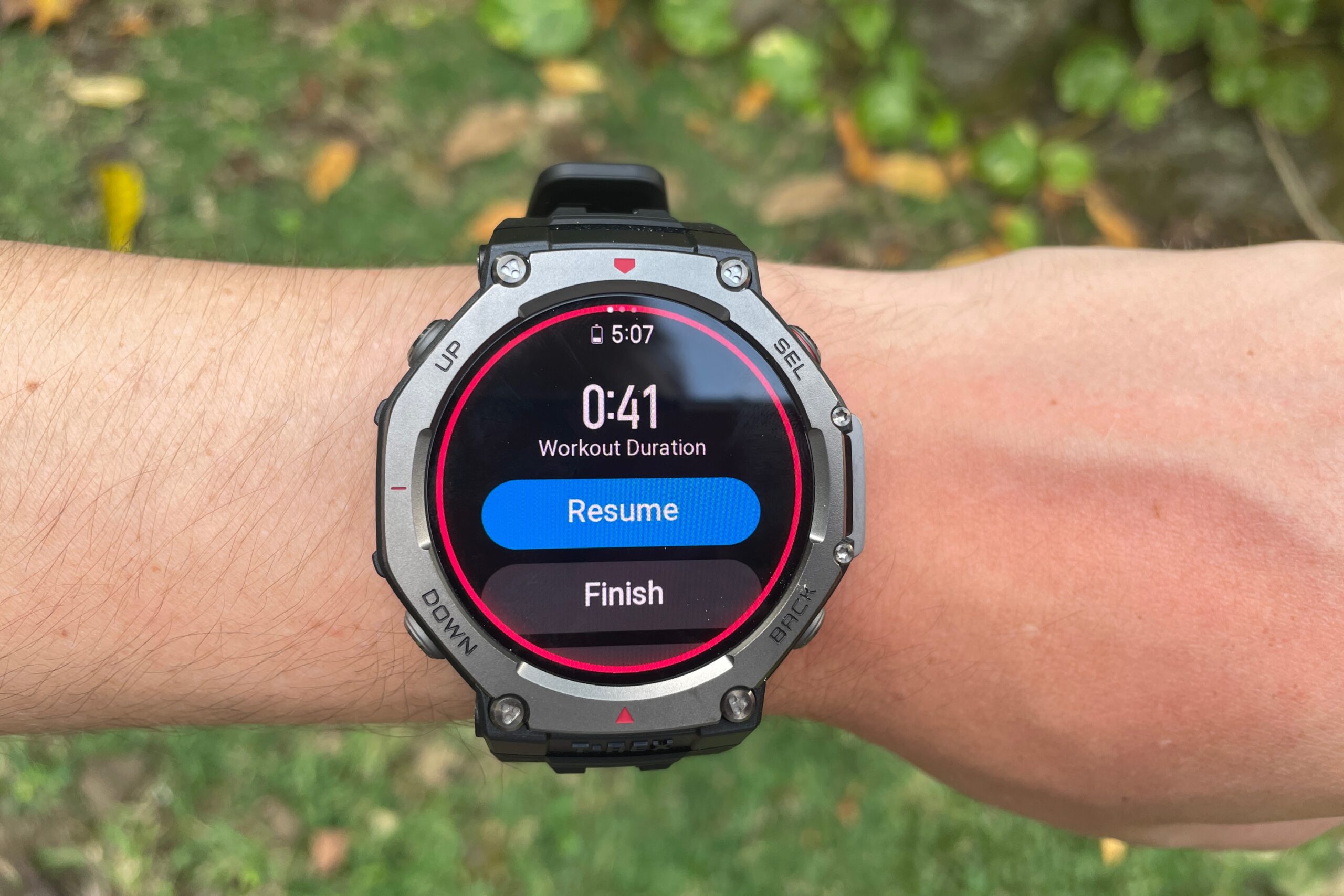
Conclusion
When choosing a GPS watch, prioritize the features and details that align with your activities and intended use. For backcountry adventures, orienteering, or off-trail exploration where navigation is key, focus on a product with strong mapping features and reliable satellite accuracy. If fitness tracking and daily wellness are a priority, look for in-depth training and health metrics. For expeditions and long adventures, durability and battery life are top priorities.
With the right GPS watch, you can confidently track your adventures, improve performance, and stay safe outdoors. Whether you are just starting your journey into the world of GPS watches or you’re a long-time user, this guide is a thorough and honest resource to aid your decision-making process when choosing your next watch.


